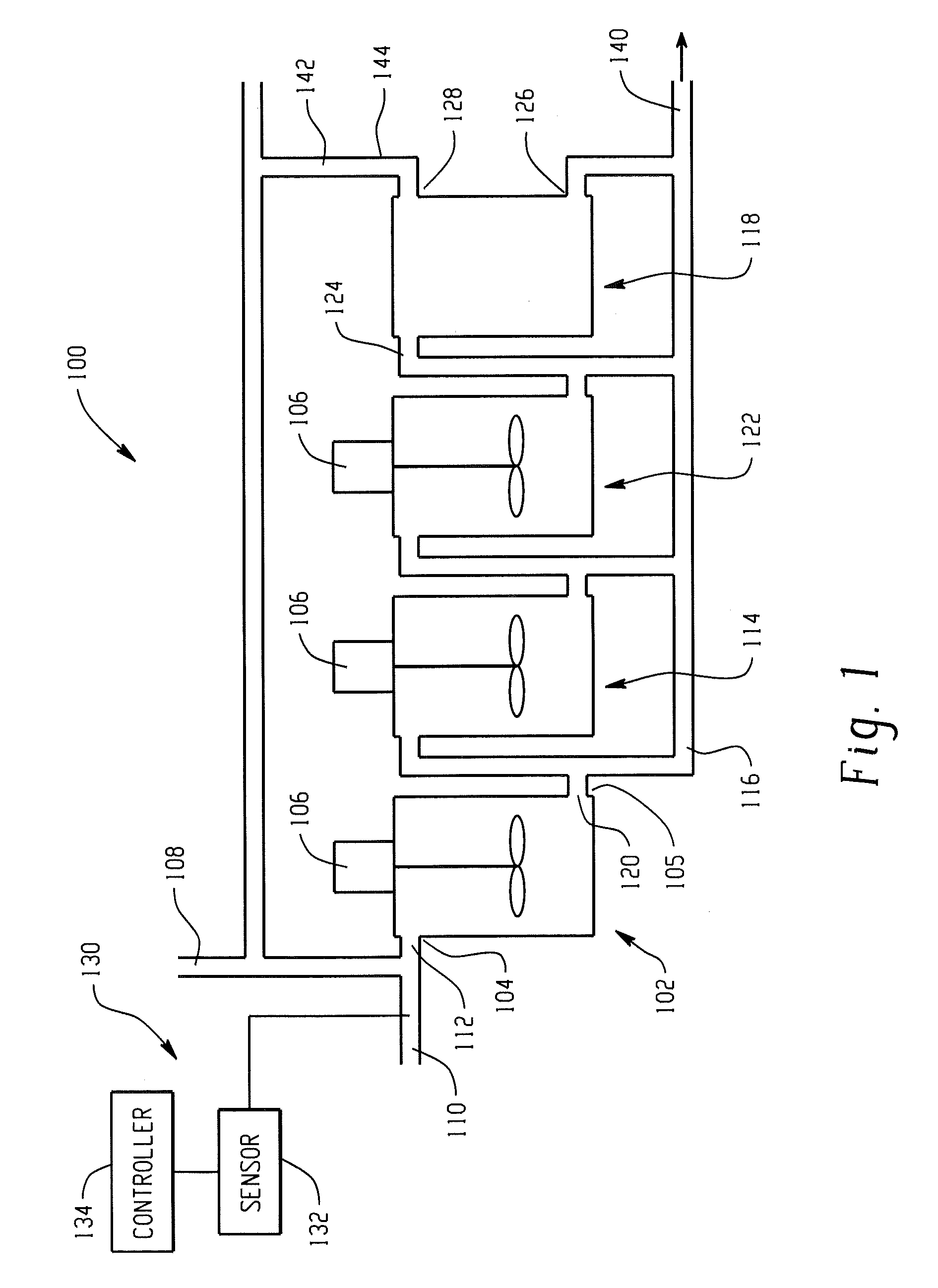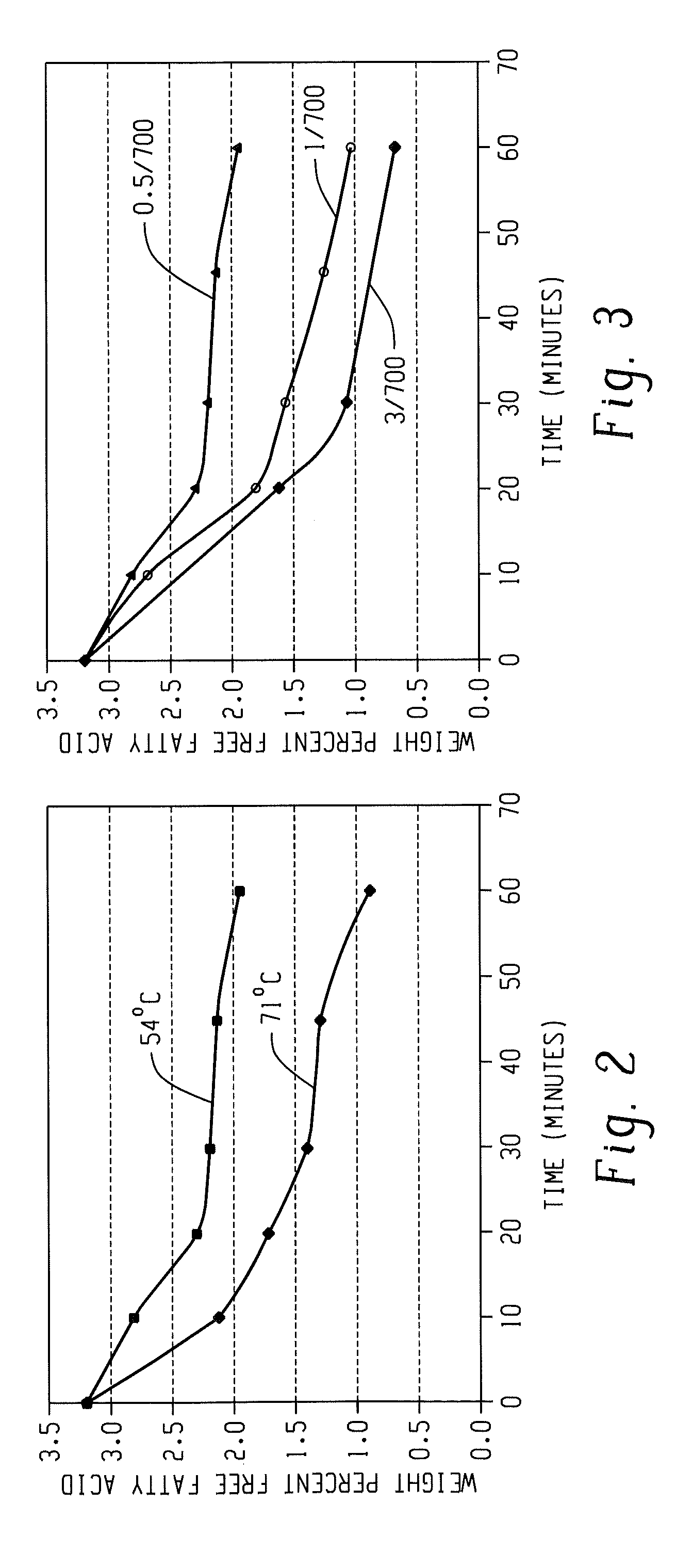Methods and systems for pretreatment of an oil stream
a technology of oil stream and pretreatment method, applied in the field of oil and grease pretreatment, can solve the problems of vegetable oil conversion, difficult processing, and large loss of yield, and achieve the effects of efficient, selective, continuous and economical processes
- Summary
- Abstract
- Description
- Claims
- Application Information
AI Technical Summary
Benefits of technology
Problems solved by technology
Method used
Image
Examples
example 1
[0063]A 1,000 milliliter (mL) flask served as the CSTR / separator in this example. Three different oils were tested. In each sample, 700 mL of the oil was mixed with 200 mL of methanol and various volumes of HCl in the 1,000 mL flask on a magnetic stirrer at temperatures of about 54° C. to about 71° C. Sample 1 included 700 mL of a soy oil containing about 3 mass % FFA. Sample 2 included 700 mL of a canola oil containing about 1.2 mass % FFA. And Sample 3 included 700 mL of a commercial yellow grease containing about 3.2 mass % FFA. Results from the reaction with the yellow grease are illustrated in FIG. 2. FIG. 2 shows that the reaction proceeds more quickly at higher temperatures (about 71° C.), and that the conversion of FFA goes through a plateau period from about 20 to about 40 minutes into the reaction. FIG. 3 shows the FFA conversion as a function of time for varying HCl concentrations, with the concentrations in units of mL acid per 700 mL of oil (e.g., 0.5 / 700 is 0.5 mL HCl ...
example 2
[0064]In the second experiment, larger scale reactions were conducted in a 100 gallon CSTR / separator vessel having a valved outlet at the bottom of the vessel. The reaction kinetics were verified under less ideal mixing conditions (e.g., although an agitator was used, thorough mixing was not attained). For Example 2, only commercial yellow grease having a FFA concentration of 3.2 mass % was used. The concept of separating and recycling was able to be tested and verified in the larger vessel. Again, the grease was reacted with methanol and HCl according to the amounts reproduced in Table 1 below.
TABLE 1OilFFA startCH3OHHClFFA endSampleVol.conc.Vol.Vol.Temp.Reaction(massNo.Experiment(gal.)(mass %)(gal.)(gal.)(° C.)time (hr)%)4Yellow5003.220122140.75Grease5waste grease 1306.57.50.08792216.50.866waste grease 2505.512.50.184922140.87waste grease 32565.50.0662214.50.78
[0065]Based upon the above examples, it can be seen that the present system utilizing the selective HCl catalyst in the me...
example 3
[0067]In the following Samples, temperature was held constant at 70° C. for all Samples tested. Reactions were carried out in a 1 Liter (L) three-neck round bottom flask with a water-cooled reflux condenser to minimize methanol losses. The flask was submerged in a water bath placed on a temperature controlled magnetic stirring hotplate from Fisher Scientific. The reaction temperature was monitored by thermocouple and a mercury thermometer and held within plus or minus 1° C. of 70° C. Agitation was provided by a magnetic stirrer (1.5 in.×0.75 in. diameter / 3.81 cm×1.91 cm) at 700 revolutions per minute (rpm). Sample 12 was repeated at 800 rpm and the initial rate of disappearance of linoleic acid was compared to the same experiment conducted at 700 rpm to verify that the mixing was sufficient to prevent bulk mass transfer limitations.
[0068]Linoleic acid concentrations ranged from 2 mass percent (mass %) to 15 mass % of the initial soybean oil-fatty acid mixture. Acid catalyst concentr...
PUM
| Property | Measurement | Unit |
|---|---|---|
| mass % | aaaaa | aaaaa |
| Reynold's number | aaaaa | aaaaa |
| time | aaaaa | aaaaa |
Abstract
Description
Claims
Application Information
 Login to View More
Login to View More - R&D
- Intellectual Property
- Life Sciences
- Materials
- Tech Scout
- Unparalleled Data Quality
- Higher Quality Content
- 60% Fewer Hallucinations
Browse by: Latest US Patents, China's latest patents, Technical Efficacy Thesaurus, Application Domain, Technology Topic, Popular Technical Reports.
© 2025 PatSnap. All rights reserved.Legal|Privacy policy|Modern Slavery Act Transparency Statement|Sitemap|About US| Contact US: help@patsnap.com



